#Bdx17 from barrel: The Médoc, part I
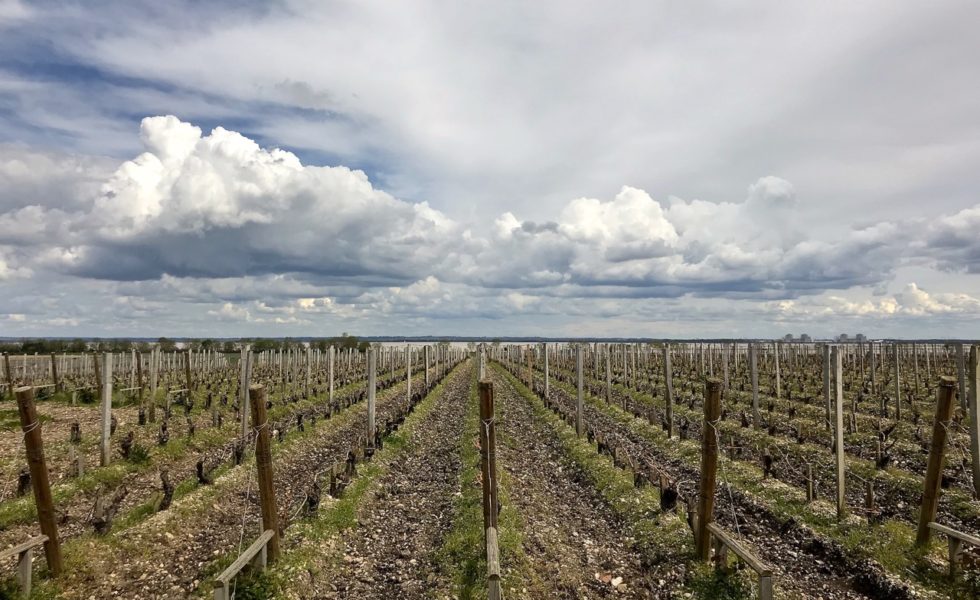
Pauillac – Saint Julien – Saint Estèphe
By Panos Kakaviatos for wine-chronicles.com
17 May 2018
As said in previous reports, Bordeaux 2017 is hard to categorize. Despite attempts at “buzz” from collective critical scores on the likes of Wine Lister, and merchants hyping the latest priced barrel issue, it is not exactly 10 hours of crickets chirping, but it is not a mad rush to buy, either.
Given recent releases, I wonder sometimes if châteaux so far are getting prices “right”. The dollar may be stronger now, sure, but so far prices have not gone down to 2014 levels: that’s where many merchants (logically) expect them to be. Sure, some estates made great wine in 2017. But overall, this is a vintage that calls for careful pricing.
As one influential merchant from the U.S. told me this month: “I am not taking orders from Bordeaux negociants, but taking orders from clients and then – based on those orders – buying from Bordeaux,” he said. “This is not 2015 or 2016.”
Whatever the case may be, here some of my reflections on three exciting appellations from the northern Médoc. The Médoc, part I thus covers Pauillac, Saint Julien and Saint Estèphe. Part II covers the Moulis, Listrac and Haut Médoc appellations. Part III will cover Margaux. So stay tuned …
Pauillac
Like other parts of the Médoc, properties with higher terroirs, closer to the river and with heat retaining gravel tended to do best in 2017. They had less or zero frost problems and ripened grapes better given the somewhat sunless albeit generally dry summer. More optimally draining soils dealt better with September rains, although nowhere were these rains welcome.
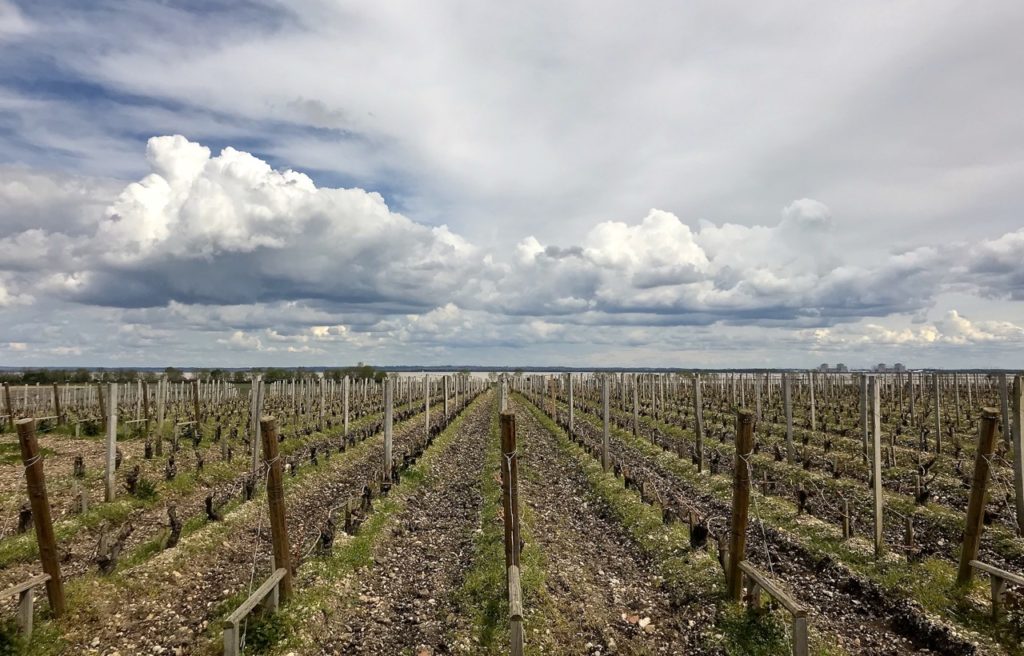
Could you see the river? If so, a distinct advantage against 2017 frost. Photo from the vineyard of Château Meyney in Saint Estèphe
I did not get to taste three of my favorite Pauillacs (Pichon Baron, Pontet Canet and Grand Puy Lacoste) this time around. I heard that they were all very good, but will catch up later this year, so look for an update.
Meanwhile, it was good to assess the three first growths as well as such celebrated wines as Lynch Bages and Pichon Comtesse, as these two count as top wines from 2017. Although most did not reach the heights of 2016, Pauillac as a whole seems to have performed very well indeed.
Top Pauillacs that I tasted include Lafite* as number one, followed by Latour, Mouton, Pichon Comtesse and Lynch Bages. As said, I missed the tastings for Pontet Canet, Pichon Baron and GPL, but this will be updated.
Tasting Notes – As usual, if in bold, I liked in particular; if red and bold, even more. If underlined, too? A kind of barrel tasting nirvana ?
Château d’Armailhac – Aging in 40% new oak and look out: prices will be going up further as the estate is floating a new second wine for the label … Its lovely perfumed nose is endearing, with fine powdered cocoa and cassis. Tannins a touch strict, so this wine is not as refined as, say, Château Duhart Milon, tasted just before. There is fine energy à la 2014but not quite the evident richness of 2015. Tasted again at the UGCB, and not as open as it was at the château. In any case, the freshness on the finish – cranberry cracking – pleases. It is actually gets quite nice with time in glass. 91-93
Château Batailley – I like the depth on the nose. There is oak, but not as much as in previous vintages such as 2014, where the oak dominated too much. The palate tightens up; the tannins somewhat stolid, and I am not as sure about the finish here. Still, the mid palate carries Pauillac power and weight. Should be fine from bottle. 90-92
Château Clerc Milon – Tasted at Château Mouton Rothschild, this wine clocks in at 13.2% alcohol, blending 60% Cabernet Sauvignon, 23% Merlot, 14% Cabernet Franc and some Petit Verdot and Carmanère. Deep and perfumed, more “serious” and greater density than d’Armailhac. Grip and subtle depth. A similar tasting experience at the UGCB: Greater depth on the nose here than Batailley, tasted just before. There is substance and a long finish. Rather positive, as experienced at the estate. Not the “super wine” of 2016 – it made by “Top of the Pops” selectionlast year from barrel – but impressive nonetheless. 92-94
Château Croizet-Bages – A charming rather “soft paw” delivery, even if the tannins are not the ripest. At least there is no sense of extracting under ripe grape pips. Not offensive, but nothing to seek out, either. 87-89
Château Duhart Milon– The estate lost five percent if its vines to frost, as some lower northwestern facing plots suffered. Blending 76% Cabernet Sauvignon and 24% Merlot, this has to be one of the finest examples of Duhart that I have tasted from barrel, ever, as it exuded a truly supple aspect and in no way was it “wanting” on the mid palate (which seems to be an issue for some 2017s). Its fresh plum like fruit, sap driven, is complemented by a just slightly creamy texture exuding harmony and elegance on the palate, finishing on fresh and floral note. A gorgeous wine, and barrel aging will “fill it out” even more of course. I would have been a buyer but the price in the end is too high as now released. As some observers point out – thank you Marcus Stanley – you can find comparable and even better wines like Château d’Issan (Margaux) from 2015 for nearly $15 less per bottle, already in bottle in current prices (18 May 2018) in the U.S. found on wine-searcher.com (see photo below). 92-95
Château La Fleur Peyrabon – Shows some austerity and hard tannin. Note reserved.
Château Grand Puy Ducasse – Tasty if a touch under ripe, as if biting into a plum that is a bit hard and lacking juiciness. But I like its mid palate weight and density. Tasted again at Château Meyney in Saint Estèphe: a bit better, but tannins again rather strict. No doubt time in bottle will soften them, and the mid palate weight will show through, but not among the better Pauillacs. 88-90
Château Haut Bages Libéral– Tasted just after Grand Puy Ducasse, and a superior sample. It conveys more juice and mid palate sap and just as much weight. There is more pleasure here, more juiciness and evident ripeness, even if it is not show stopping good. 89-91
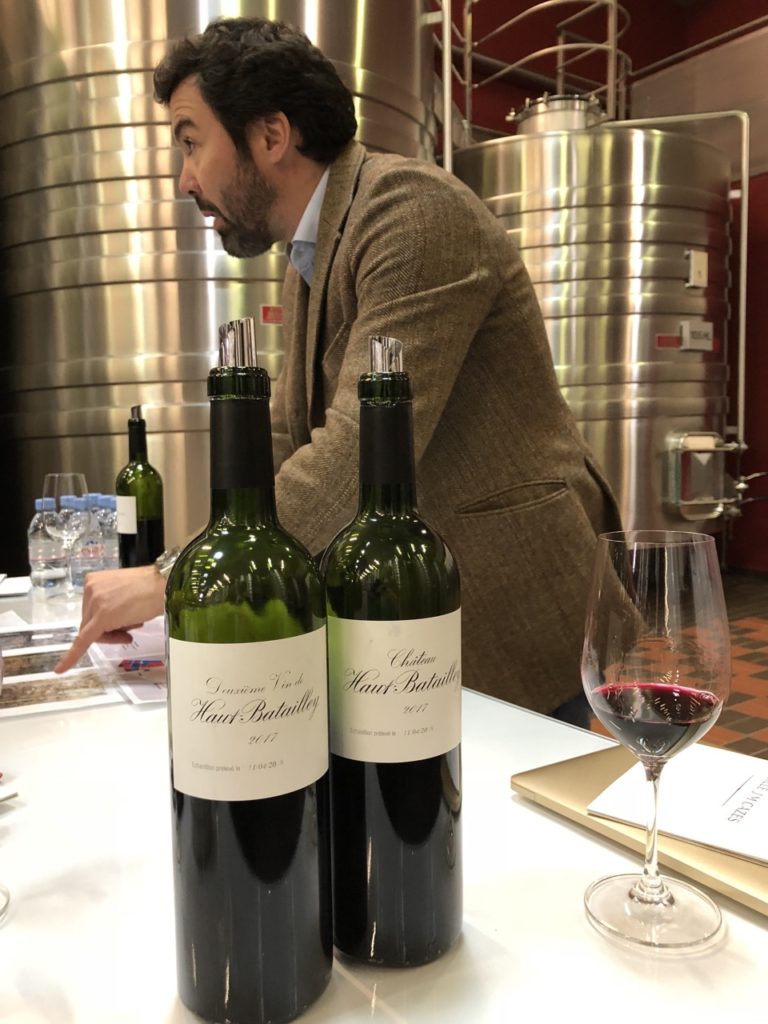
I did not taste this wine, but I admire Miguel Lecuona’s palate, whose notes appear here, as well his photo of Jean-Charles Cazes.
Château Haut Batailley– This note is by Miguel Lecuona of City Wine Journal, a palate I trust: Nose with a bit of tension between red fruit and brioche. Bright, with plum and firm red berries, holding that tension into the finish. The fruit will continue to push through to keep things interesting. Hold then drink 2025-2035.The wine clocks in at 13.6% alcohol with a healthy pH of 3.6 and sound tannin index of 67. Again, and this line is my own, a more successful example it seems of wines that have more tannin and structure than the image of the vintage allows.
Château Lafite Rothschild*– Candidate for wine of the vintage. I put in a preliminary order as I write this, for a pack of six… if the opening price is reasonable enough. Hope springs eternal? The 2017 vintage is not “of the century” material so pick the big names and in this case, you will get fantastic wine. Aging in 90% new oak “because we want to try out a bit less,” remarked estate director Eric Kohler, the wine clocks in at 12.8% alcohol and blends 96% Cabernet with 3.5% Merlot and the rest a tiny bit of Petit Verdot. The aromatics? Gorgeous, rich and perfumed – and among the most aromatically impressive Lafites I have tried ever from barrel. There is such refinement, subtle opulence and a long finish. The pH – at 3.75 – is “a little high” but one does not get the sense of a wine that lacks spine or energy. Like others, Kohler said that he could have done without the rain, but it created “more anxiety than disease,” because grapes were in good condition. “We saw that the quality resisted the rain, even if we had a little bit of dilution,” he said. “If I had a choice, I could have done without the rain.”
But the good news as Kohler explains:
We did not need to wait for more ripeness; vintages that had been stopped by the rain, before maturity, for example include 2011, which began like a great vintage of concentration. But it was a bit late, and when the rain arrived, the grapes needed 10 days more. 2006 was also like that. That was not the case in 2017.
In any case, miles better than Duhart – and I really liked Château Duhart Milon as a sure buy in 2017 – with superior density and freshness. Will the price difference justify the quality difference? The crop was a healthy 37 hectoliters per hectare. 96-98
Château Latour – A very successful first growth that outpaces Margaux and Mouton but perhaps not as great as Lafite (and about a tie with Haut Brion?) The wine has a plump and rich nature – a creamy mid palate, opulent and velvety in texture. The length is fresh and with much lift, marked by iris and violet floral aromatics. This blend of just over 92% Cabernet Sauvignon, and just under 8% of Merlot with a tiny bit of Petit Verdot yields noticeable tannins but – in character with the vintage – the IPT index is not that high at 66, and alcohol is just over 13%.
For technical director Hélène Génin, the vintage seems to be “between 2012 and 2014” because it has “2012 plumpness” and the “energy, freshness and aromatic qualities of 2014.” Les Forts– the second wine – came across as stricter in terms of tannic expression but again it exuded a kind of refined and creamy texture. The Pauillac (third wine) was very fresh and easier to drink, but that is normal. Génin said that the September rains – about 100mm – made the harvest more challenging, and difficult choices needed to be made about how much bleeding of the vats was needed and to what extent press wines could lend more concentration to the wines. In the end, she crafted a great first growth. 94-96+
Château Lynch Bages – Lovely nose here, perfumed. Lily of the Valley and white floral aspects along with red fruit and subtle dark chocolate aromatics intrigue the taster. There is a ripe palate, indeed, albeit somewhat rigid tannins mark the finish line, but barrel aging will soften these edges, as the fruit is ripe. A very fine Lynch Bages: if the price is right, seek it out. As I revisit the sample, I want to drink it: it has that charming and engaging palate à la 1985. Bravo! 92-95
Château Lynch Moussas – Far lighter in scale, this Lynch. A bit under ripe? And the finish is short. Hmmm. Not reserved.
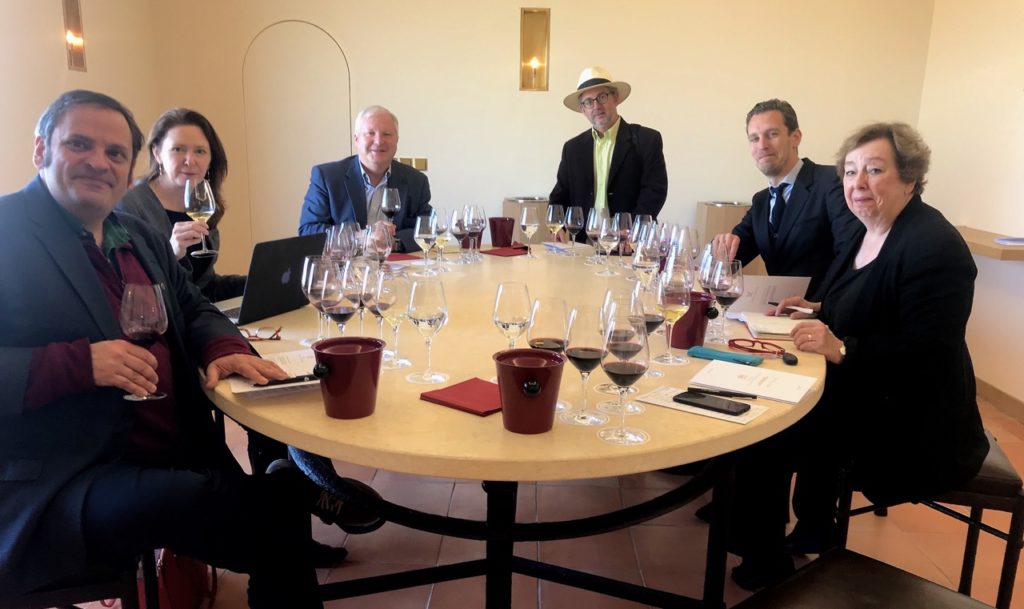
Tasting at Château Mouton Rothschild with – from left to right: myself, Jane Anson, director Philippe Dhalluin, Miguel Lecuona, Francis Anson and Elin McCoy of Bloomberg.
Château Mouton Rothschild – Of course the 2016 had more tannin than in this vintage, but the wine here exudes wild red berry and pure cassis notes, as well as a deep, opulent and vinous palate. There is veritable mid palate juiciness typical of top wines from 2017, with 12.9% alcohol and a long, cool finish. Sure, there are some tannins just a bit strict, but barrel aging will soften them, and you will end up with a fine Mouton. Not the most exciting of the vintage among the very top wines, but robust and intense, blending 90% Cabernet Sauvignon, 9% Merlot and 1% Petit Verdot. 93-96
Château Pedesclaux – Comes across as rather substantial on the palate, although it feels a bit extracted, with somewhat hard tannins. Does not have the impact of the 2016, for example, and I get the impression of an estate that is trying to make a Maserati from an Audi. Note reserved for now, and I would prefer to revisit.
Château Pichon Longueville Comtesse de Lalande – This has excellent density and focus. But what really impresses is the density. Add to this spice and charm and fine length and you have a wine that is great. There has been a consensus view that one of the top wines of 2017 is this one. This tasting confirms that consensus. Magnificent ripeness and freshness and a long, juicy finish. Bravo! 93-95+
Reserve de la Comtesse– Really nice second wine: smooth and supple, there is a Merlot plump aspect. Damson and spice. This has drinkability. Juicy frame and delivers. 90-92
Saint Julien
Given the characteristics that helped properties excel in 2017, it came as no surprise that properties like Beychevelle and Léoville Barton – whose vineyards “see the river” – excelled. More inland estates dealt with frost and were not quite as successful. Because of writing assignments from Decanter to focus on a feature hundreds of Bordeaux AOC wines from the 2016 vintage, I missed three stars of Saint Julien: Ducru Beaucaillou, Léoville Las Cases and Léoville Poyferré, but include tasting notes from friend and fellow blogger Miguel Lecuona of City Wine Journal. Miguel has a great palate!
Top wines from what I have heard and read should include Ducru Beaucaillou and Léoville Las Cases as well as Léoville Poyferré, which I did not taste. Of those I did taste, my most surprisingly positive note has to be Beychevelle, but I also very much liked Léoville Barton.
Château Beychevelle– One of my overall favorites from 2017 in the Médoc and punching (well) above its weight in this vintage: Lovely nose, ripe bright fruit and distinct floral notes. Bouquet freshness and depth? You bet! The palate exudes class and breed, and the finish is long. With barrel aging, it should develop nicely. 92-95
Château Branaire-Ducru– While not as engaging as Beychevelle, the aromatics combine floral, herbal and red fruit. The palate is robust for the vintage, with ripe fruit but in a somewhat lower key. Tasted at the château with similar results, albeit more brightness. 91-93
Château du Glana – Tasted at the Grand Cercle. A bit austere and you do not get the charm of Saint Julien here. The lack of enough sun in the summer? The September rains? Note reserved.
Château Gloria– I liked this at Vintex, I like it again here. Smooth and ripe. What more do you want really from 2017? Slightly hard tannin on the finish, but this is nitpicky. That is the type of tannin that will be tamed with barrel aging. The finish has lift. The palate is ripe. While not extraordinary, the wine should be delicious for about 10 years of drinking – and it will not be too pricey, either. 91-93
Château Gruaud Larose – Deep and subtle nose. A certain “contained power” even if not as good as in 2015 or 2016. This is rather solid and deep, has freshness and density (true to the estate style), but a tad impenetrable at this baby stage. There is a fine violet aspect to the aromatics. 92-94
Château Lagrange – Comparatively raw in aspect when compared to the Gruaud Larose, tasted just before. Not as cohesive or as deep. But on its own, it is fairly engaging. I understand that the estate suffered from frost, so perhaps better plots were lost? In any case, a solid performance. Rich, rather ripe fruit. There is a tonic freshness on the finish that I like. 90-92
Château Langoa Barton – Slightly vegetal tannin on the nose here. The palate is better, more streamlined and lip smacking, but the tannins just a bit stern. Sure, it will soften with barrel aging and in your cellar, but I do not find this to be one of the more stellar examples in recent vintages of the Langoa. 89-91
Château Léoville Barton – Riper and deeper than Langoa, already on the nose. This has elegance and refinement, and the tannins reflect better ripeness on the palate than the above – and the barrel and cellar aging will bring you a lovely wine to enjoy for years to come. Bravo! 92-95
Château Léoville Las Cases – Notes by Miguel Lecuona of City Wine Journal. The blend is 79% Cabernet Sauvignon, 11% Cabernet Franc and 10% Merlot. It clocks in at 13.28% and is aging in 90% new oak. About 7.5% press wine was used. Beautiful color red rim. Sophisticated aromas signaling great complexity. The attack takes you right to the heart of the matter — beautifully ripe Cabernet with power, expression and balance. Extremely long. More power in display than a few of the firsts, yet so well controlled. The capabilities and rugged premium appointments of a Range Rover. And more reliable in the long run! Outstanding. Will keep for decades. (This sounds like a ringing endorsement indeed!)
Château Léoville Poyferré – Notes by Miguel Lecuona of City Wine Journal. This blends 68% Cabernet Sauvignon, 27% Merlot, 3% Cabernet Franc and 2% Petit Verdot, clocking in at 13% alcohol. Quiet on the nose, but well developed in glass. Quite powerfully held in check with strong tannins and wonderful length. Fruit follows through to keep the oak well under control. Very well done: one of the top wines of the appellation.
Château Saint-Pierre– Fine, engaging and ripe nose. The palate is not as dense certainly as either Gruaud Larose or as Léoville Barton, but it is chipper and fresh – and has depth. A fine drink! 91-93
Château Talbot – A bit unsubstantial. There is red fruit here, and more medium bodied charm, but also some rigid tannins. 88-90
Saint Estèphe
Some estates here wowed me – but not as much as in 2014, which remains an underrated vintage par excellence in Saint Estèphe. While Château Montrose seems to come out on top, I was left more with a feeling of “confirmation” as in “yes, this is darn good, but kind of what I was expecting.” I did not get the same “Hallelujah moment” as I had at, say, Evangile or Lafite Rothschild. In that sense, I cannot say that Montrose counts as one of the very top wines of the vintage, but it is certainly excellent. I was also less impressed by both Calon Segur and Cos d’Estournel. Both estates made very fine wine, and Cos d’Estournel comes certainly in second place, based on the barrel samples, but neither made me go “tasting note gaga”. Perhaps the most interesting story to come from Saint Estèphe in 2017 is how some “cru bourgeois” level wines kicked ass. Meyney, Phélan Ségur and especially Tronquoy-Lalande come to mind.
Top pick? Certainly Château Montrose. But what a great performance, too, by Tronquoy-Lalande!
Château Calon Ségur – I enjoyed this wine for its combination of cool blue fruit and fine dark chocolate expressions. September rain adversely affected in particular the Merlots – constituting 13% of the blend – explained general director Laurent Duffau. The “lack of light” in the summer led to Cabernet Sauvignon – 76% of the blend – also not “optimally ripe” and yet the overall impression is of elegance and smooth style, with ripe cranberry and less dark fruit. It conveys lip-smacking juiciness. In order of preference, Duffau ranks 2016 at the top, followed by 2014, then 2017 and 2015 last. Readers should recall that rain in September adversely affected the 2015 morethan it did in 2017. The wine clocks in at 13.2% alcohol with a pH of 3.7. 91-93
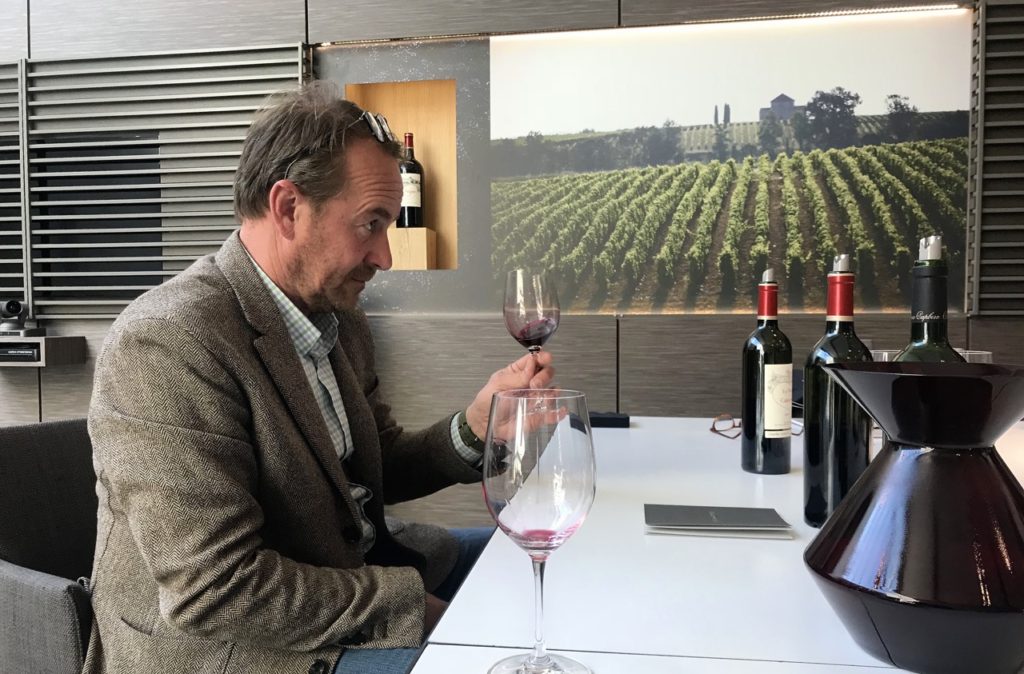
The genial and straight talking Laurent Duffau of Château Calon Ségur. He ranks his 2014 higher than the 2017.
Château Capbern – Charming red fruit expressions, flavorful. It comes across just a tad warm on the palate, this blend of 55% Cabernet Sauvignon, 39% Merlot and bits of both Cabernet Franc and Petit Verdot. Could it be the relatively low acidity of the vintage? The pH is 3.8, and total acidity 3.35. Aging in 60% new oak, it leaves an overall impression of being both rich and robust. It clocks in at 13.3% alcohol. 89-91
Château Cos d’Estournel – A wine of polish and finesse, even if it may lack a bit of vigor. Of course this is a deserved grand cru, with a grand price, so we should expect grand things, right? The blend of 66% Cabernet Sauvignon, 32% Merlot, and 1% each of Cabernet Franc and Petit Verdot does have fine juiciness on the mid palate, with fresh red fruit expressions leading to a cool blue fruit finish. Strange but I was not getting that “ooh la la” feeling that I had from the 2014 barrel sample. Still, this should be a darn good Cos and trend towards the higher end of my numerical range. Time in 60% new oak barrels will “amplify” the palate of this 13% alcohol wine to something nuanced and polished: A successful vintage that could be worth purchasing, if prices drop enough. The second wine, Pagodes de Cos, has a bit more strictness than usual in its tannin. It is however bright in fruit expression. 92-94+
Château Cos Labory – This blend of 38% Merlot, 57% Cabernet Sauvignon and 5% Petit Verdot, clocking in at 13.1% alcohol and aging in 50% new oak comes across a bit steely on the attack at the UGCB tasting, but the juice sets in on the mid palate, with an overall sense of depth. Give it time in bottle. It should be accessible and very tasty in 10 years. Nice job! Tasted as well as the negociant Joanne, and an even more positive experience: I liked the juiciness, even if a bit austere (that steely nature). Fruit driven mid palate, however, with purity of fruit and precision. 91-93
Goulée de Cos d’Estournel– Funny how I keep getting more and more impressed by this wine, as it gains freshness. How could it not in a vintage that should be known for aromatics? This gives off refinement and medium-bodied opulence, its 72% Merlot ripe and delicious, as many are old vine Merlots. Quite delicious! 89-91+
Château Le Crock As tasted by Miguel Lecuonafor City Wine Journal— This blend of 52% Cabernet Sauvignon, 34% Merlot, 8% Petit Verdot and the rest Cabernet Franc clocks in at 12.8% alcohol and was cropped at a generous 50 hectoliters per hectare. Frost? What frost? Well this is quite nice late in the afternoon on a dreary day: another bright spot. Firm and restrained, plums and spice. Good length.
Château Haut Marbuzet – I normally like this estate a lot but this particular sample tasted at the negociant Joanne seemed a bit off and kind of muddled. It basically dried out on the finish. Kind of surprising, so my note is reserved for now.
Château Lafon Rochet – Shows more depth perhaps than the Cos Labory, tasted just before, with more immediate ripeness. A robust character with underlying seriousness. The tannins may be noticeable and need to be tamed, but they are neither “hard” nor “constraining” so this should turn out very fine. 91-93
Château Lilian Ladouys – This blend of 50% Merlot, 43% Cabernet Sauvignon, 7% Petit Verdot aging in 40% new oak comes across smooth, albeit just slightly drying on the finish. Taken as a whole, it exhibits refinement as well as a rounded texture with mid palate sap. A solid value. 89-91
Château Meyney – No problem with the frost given the proximity to the river, so inversely, 2016 has freshness from the tempering nature of the river. Tasted at the château, this blend of 58% Cabernet Sauvignon, 31% Merlot and 11% Petit Verdot. showed more personality than Grand Puy Ducasse (same owners) tasted just before. The tannins are strict and yet the wine conveys nuance and density and juiciness. Good length and freshness on the finish. Tasted at the negociant Joanne, I got the feeling that it seemed a bit oaky on the finish, but with purity of fruit on the mid palate. 90-92+
Château Montrose – For this estate, the Cabernets excelled, making up 76% of the blend. Merlot counted for another 20% and the rest 3% Cabernet Franc and 1% Petit Verdot. Nine batches of press wine were used to adjust tannic density to the 82 batches of classic free run wines to bring forth a wine that is not the most powerful Montrose in recent years, but certainly aromatically appealing. It has freshness and juiciness but framed by somewhat firm tannins, and clocks in at 13% alcohol. I like the smooth texture that develops to the long finish, and yes, the tannins kick in on the finish to remind us that this is not, say, Margaux. Overall, I liked this wine, but I did not have that “ah ha” moment as I had had with the 2014, for example. The Dame de Montrose is usually one of the best second wines in Bordeaux, and while I liked its fruit and sap of the 49% Merlot and 43% Cabernet (with a bit of Cabernet Franc and Petit Verdot) blend, I could sense just a bit of dilution on the mid palate. The Montrose, however, earns top Saint Estèphe honors. 93-95+
Château Ormes de Pez– Very nuanced and refined on the nose, with fine fresh fruit (whereas the Grand Puy Ducasse seemed to have just under ripe plum; this is ripe). The finish shows someone stricter tannins and a cooler fruit profile. 89-91
Château de Pez– Although the tannins may not seem as fine grained as those of Ormes de Pez, tasted just before, this wine has a comparatively juicier mid palate: an appealing lip smacking aspect and smooth texture, with a long finish. 90-92+
Château Phélan Ségur– Rich fruit, here. Not quite as long on the finish as Château de Pez, tasted just before, and it seems to lacks just a bit of focus. But in tasting over time, I do like its power and rigor: very “Saint Estèphe”. 90-92
Château Tronquoy-Lalande – Tasted with several friends at the château, this wine actually impressed me more than Montrose – in terms of its more moderate price tag. You expect Montrose to be at least excellent. And it was. But this estate in the past has sometimes come across as a bit heavy in vintages like 2009. But in 2017, it exudes gorgeous fresh expressions of ripe fruit, with an elegant finish marked by lift. Sure, the 13.5% alcohol includes a rich, ripe Merlot expression (55% of the blend). Just as I had been so impressed in 2016 by Château Potensac as a value wine to buy, I got a similar reaction to this estate in 2017. Very good! 91-93+
 Wine Chronicles
Wine Chronicles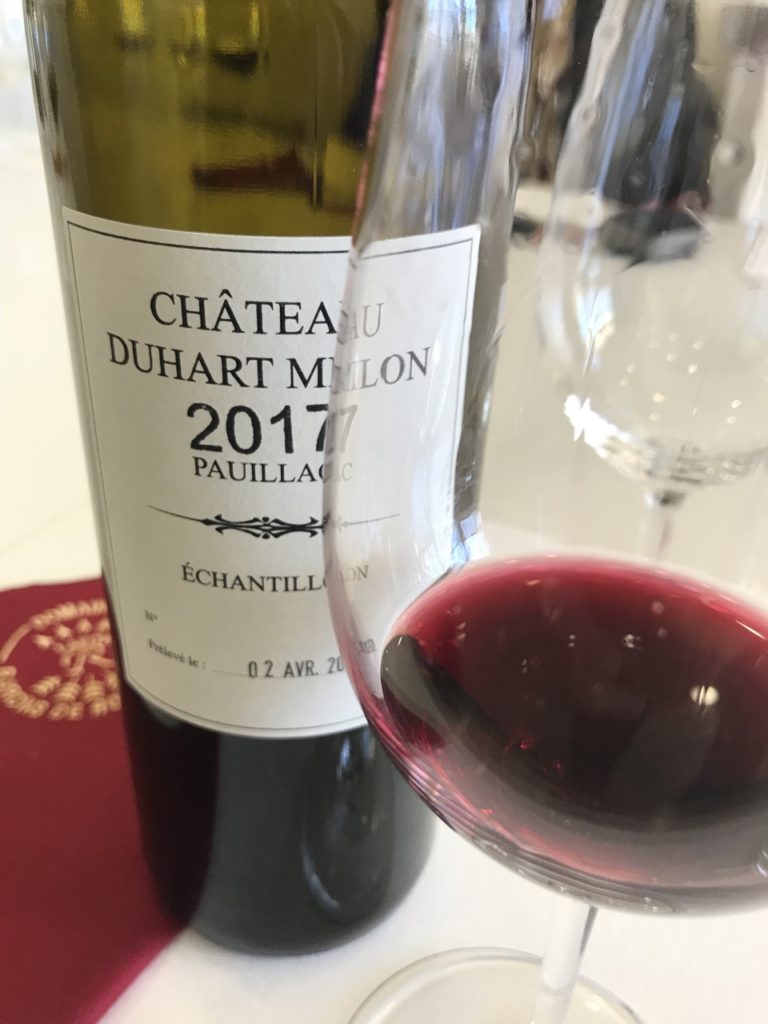
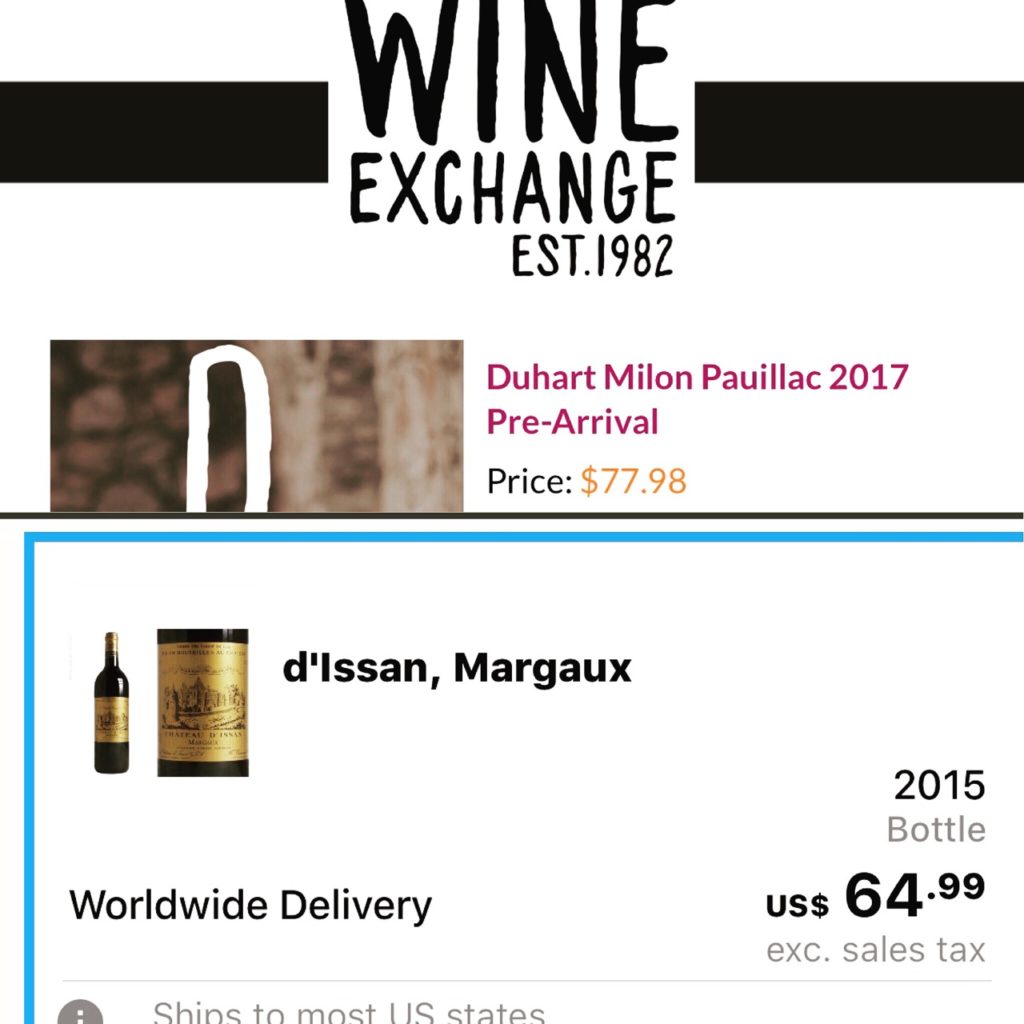
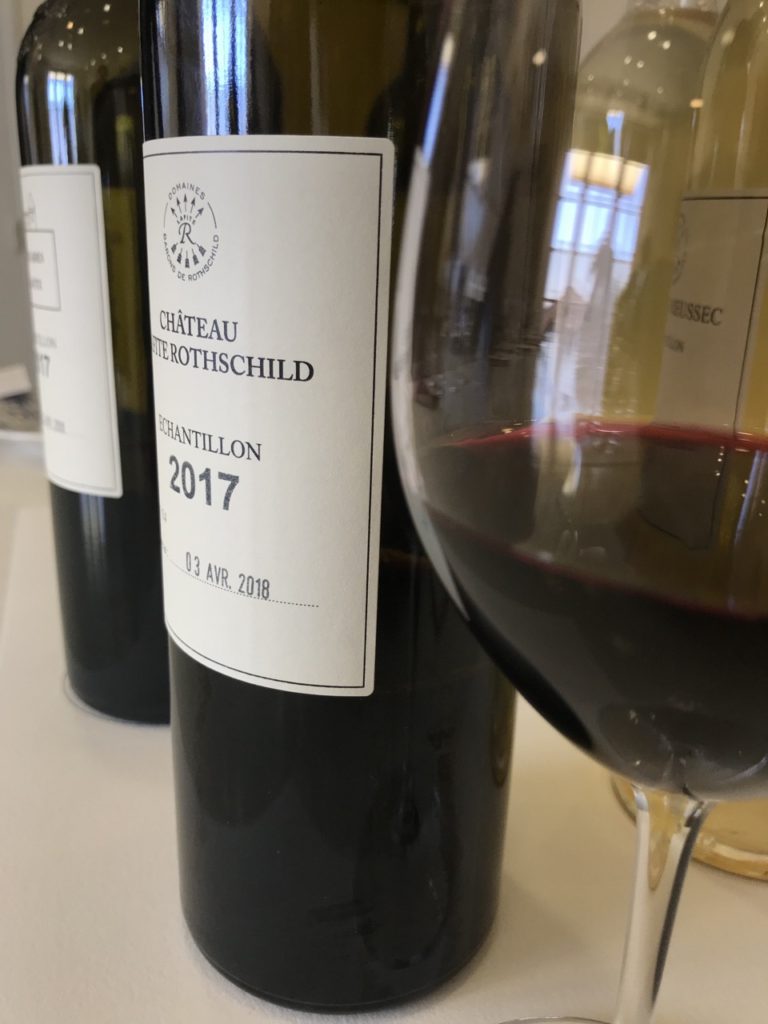
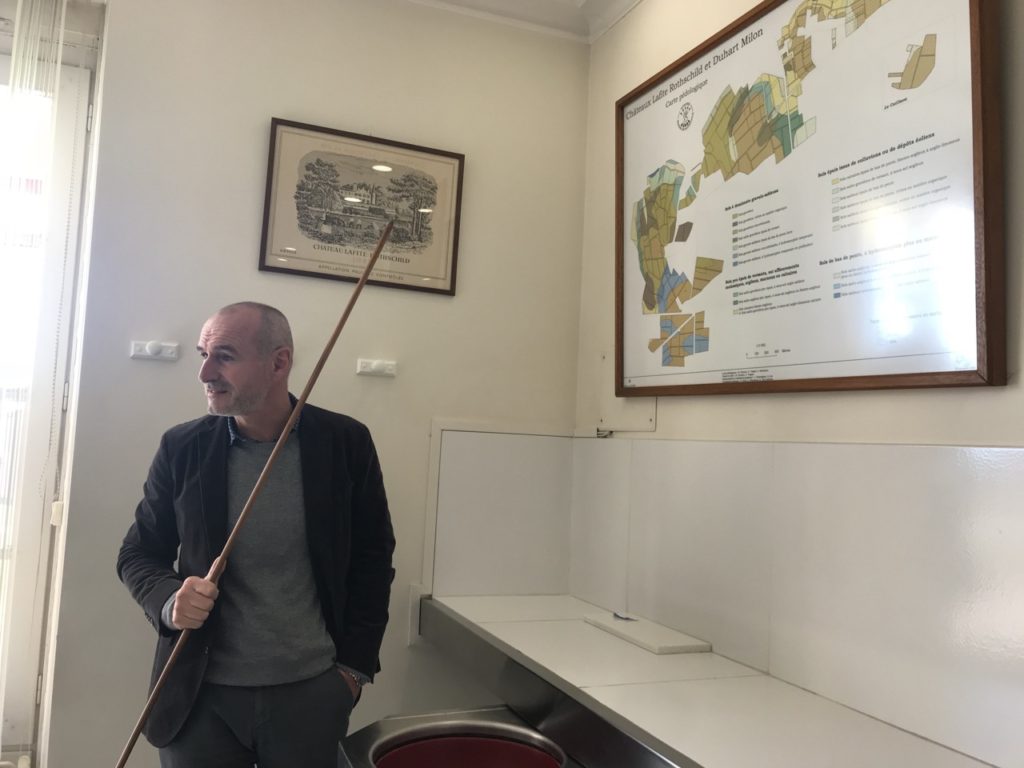
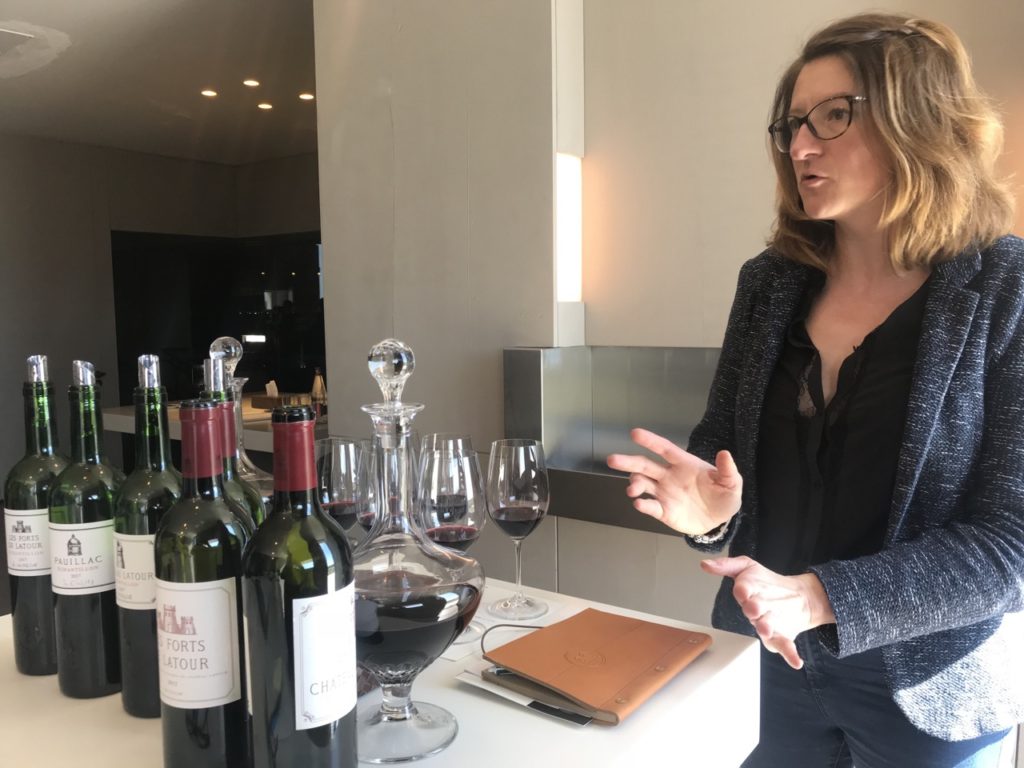
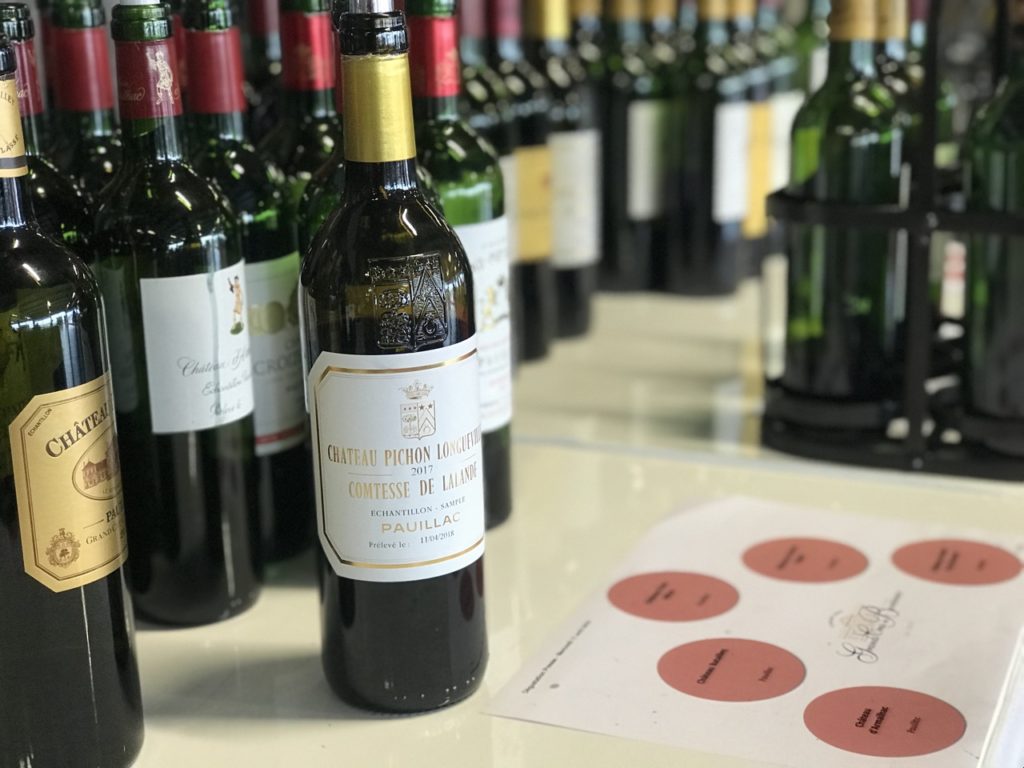
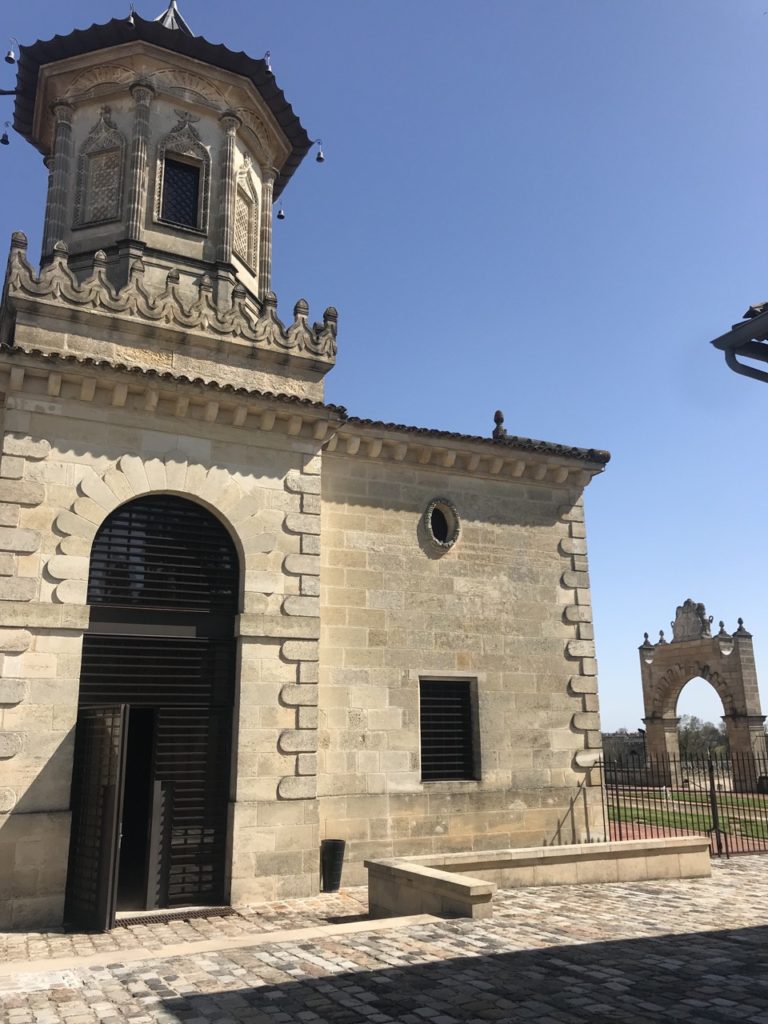
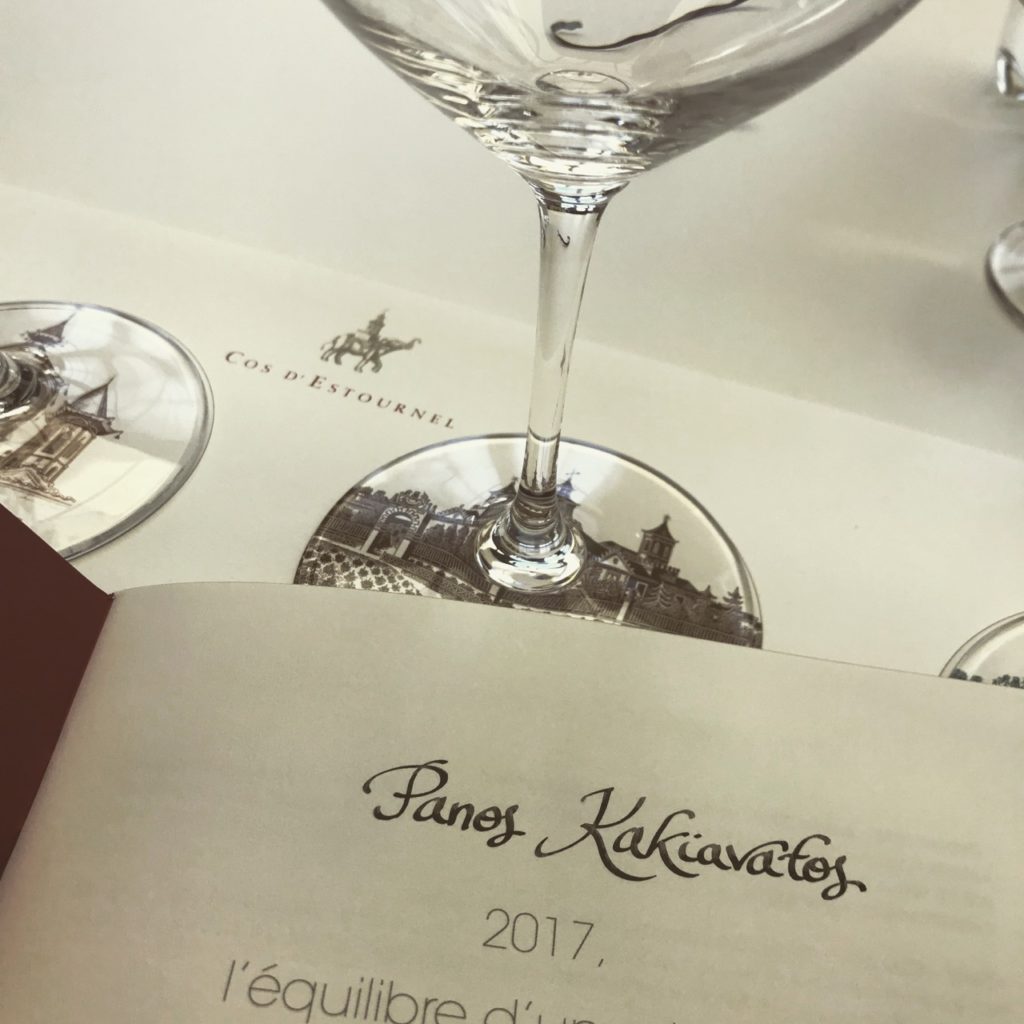
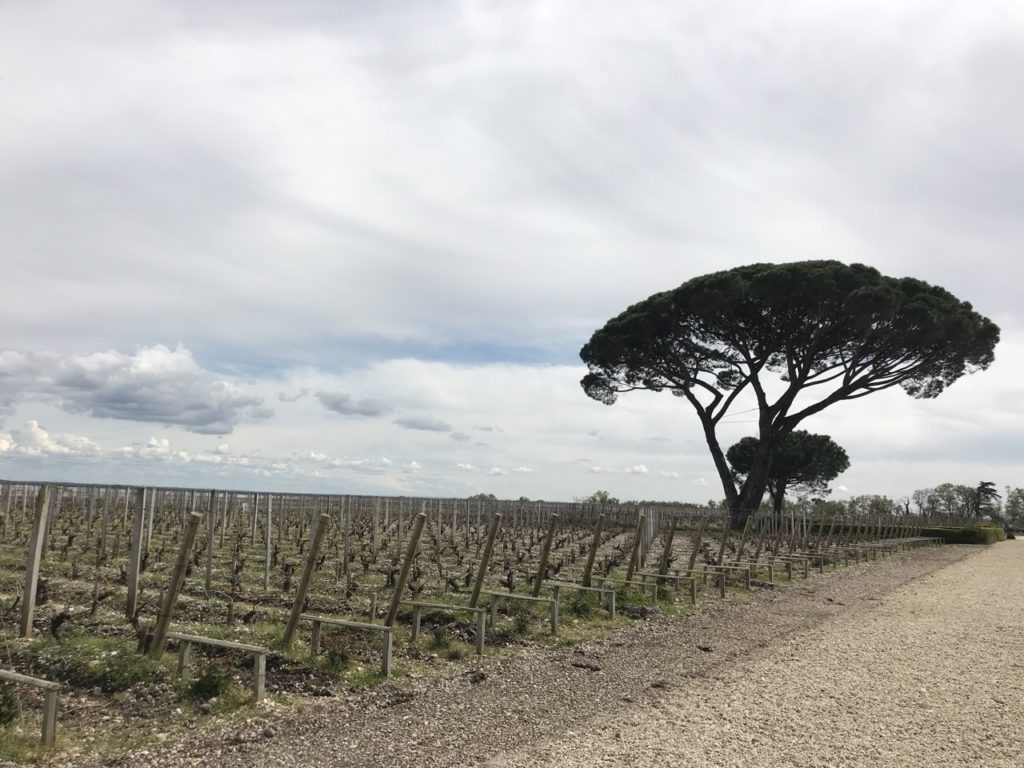

Share This